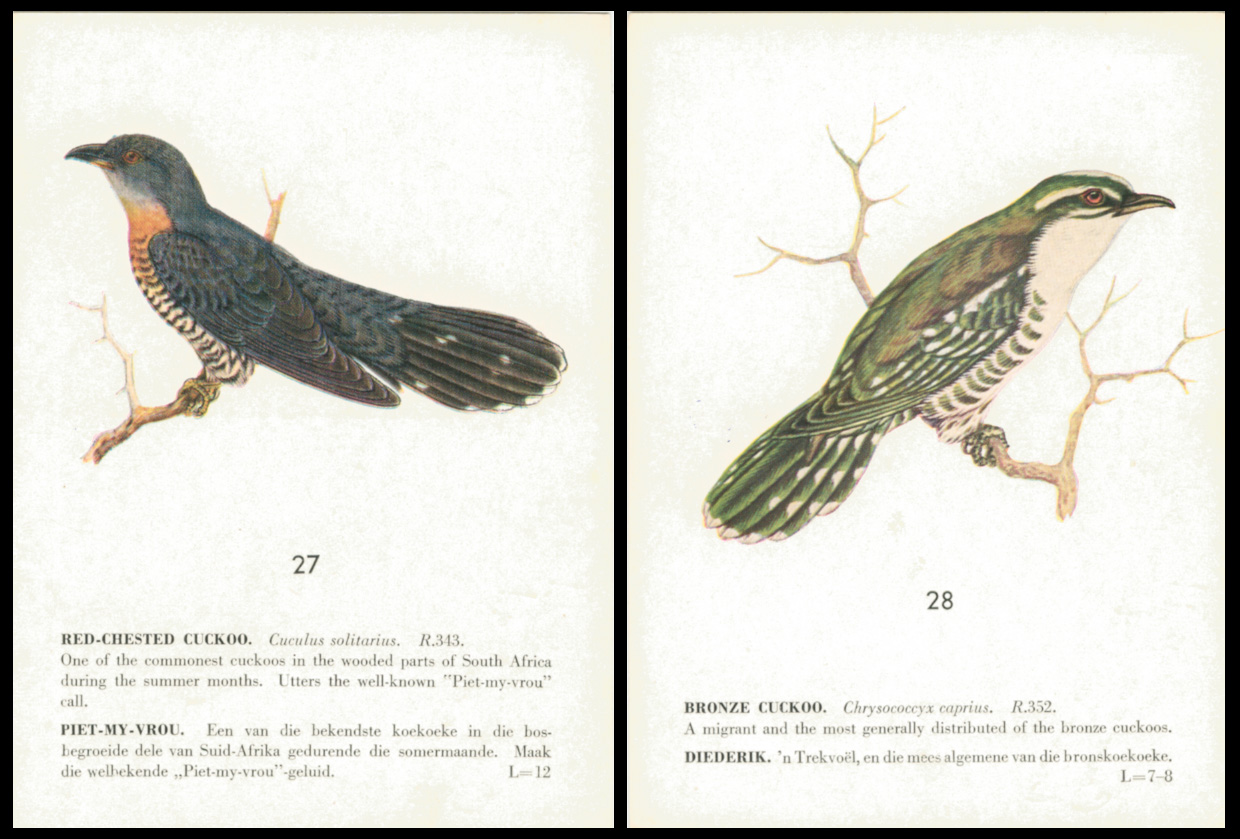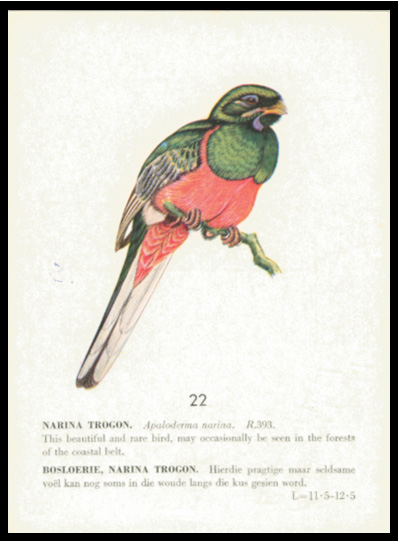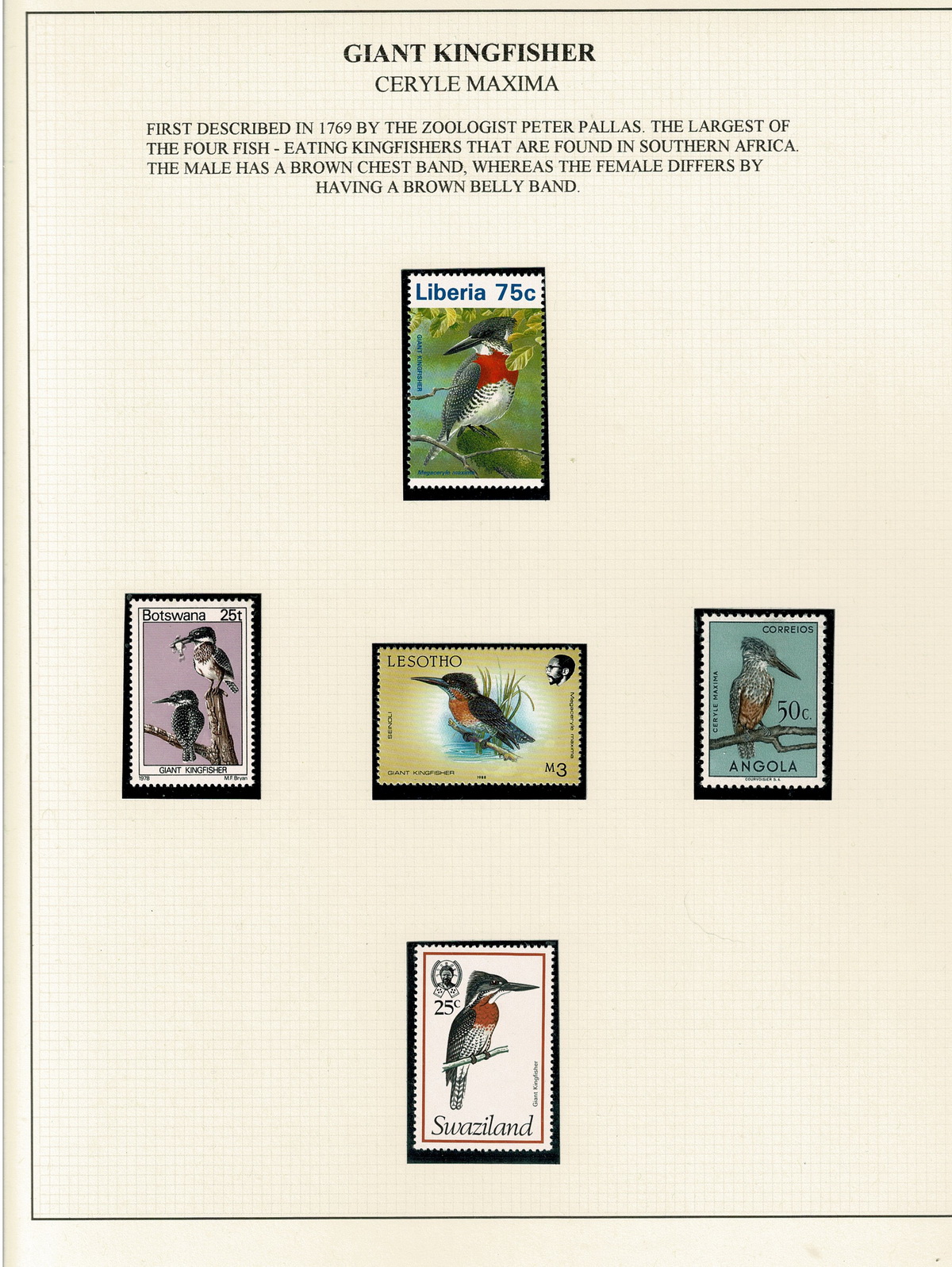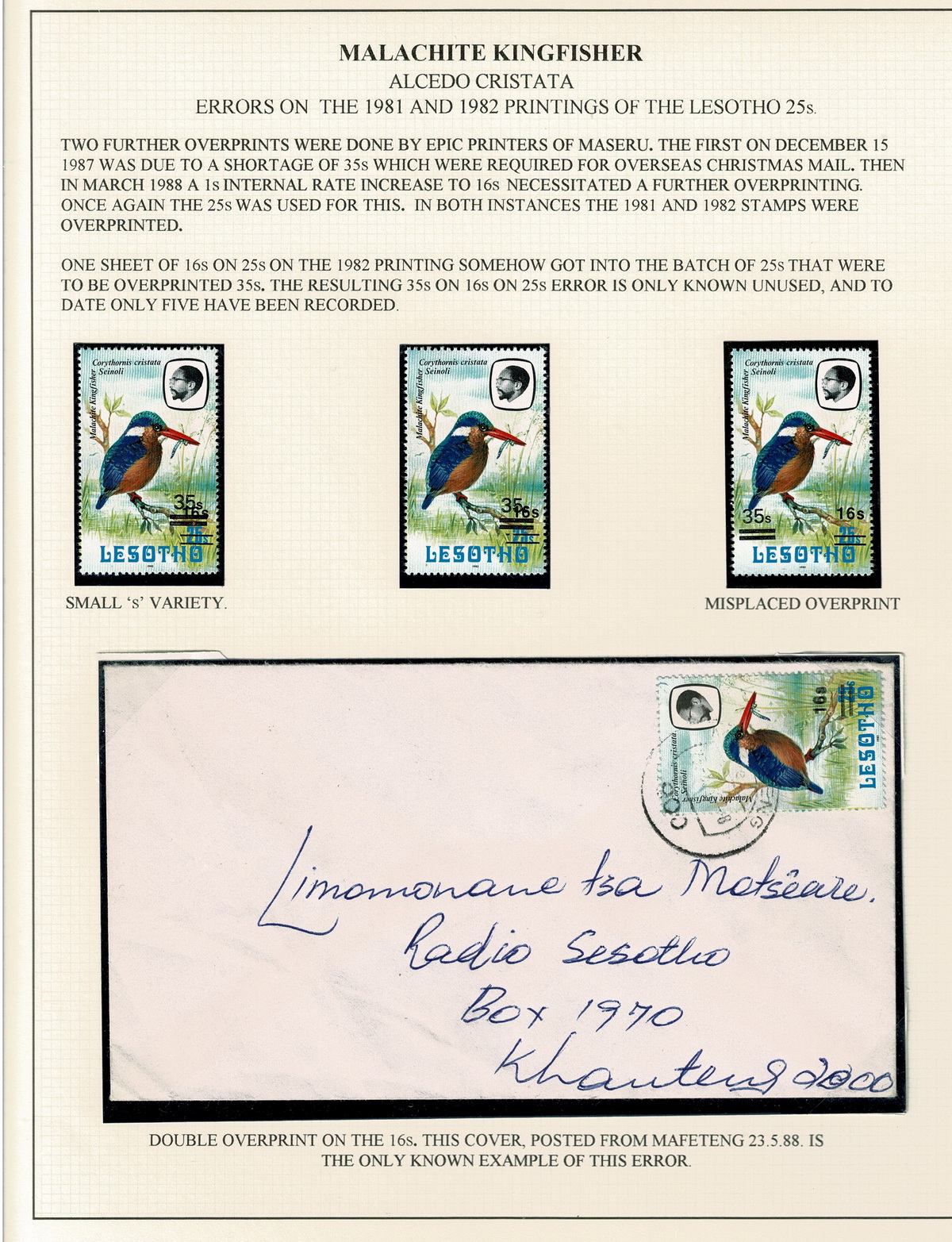Ornithology & Philately
Quote from Steve on June 12, 2020, 4:01 pmIn the time since I joined the South African Collectors' Society some four or more years ago I have met almost as many ornithologists as I have stamp collectors. It really is surprising the number of British philatelits and postal historians who have a love of South African birds and who visit South Africa to see them. One such South African Collectors' Society member is Mike Berry who collects both Natal and now Cape of Good Hope pre-adhesive postmarks. Without ever living in South Africa Mike is only about 100 sightings short of seeing all of South Africa's 958 birds, an achievement made over many years and visits. Mike phoned me today and I told him that as it was my wife's birthday we had been on a walk close to Wicken Fen where we met a bird-watcher observing cuckoos. For those who do not know this, the African cuckoo flies to the UK every year, hangs around in the trees of Wicken Fen and waits for a reed warbler to leave its nest. It then flies in, kicks the reed warbler's eggs out and replaces them with one of its own. This done, the cuckoo returns to Africa and the reed warbler brings the cuckoo fledgling up as its own. Now for the amazing part. Having grown strong and healthy, the young cuckoo departs the nest and Wicken Fen and flies to Africa. How did it learn to do that? Certainly not from the reed warbler who thought it was its own and certainly not from its absent parent! I told Mike about our meeting with the bird-watcher and he said to me "You do know that South Africa has thirteen types of cuckoo, don't you". Well, of course I didn't. Why would I? Mike was flabbergasted. (That sounds like a type of bird, the African flabbergaster.) "What? Not even Diederik's Cuckoo?" No, not even that.
I have about 78 South African Bird Postcards, "Some Protected Birds of the Cape Province", produced by the Dept. of Nature Conservation, possibly in the late 1950s, early 1960s. They are very attractive but Mike was unimpressed when I offered them to him. He prefers to see 'em and snap 'em in the wild, And who can blame him. I thought "I wonder if his Diederiks Cuckoo is among that lot of postcards he rejected". Much to my surprse it was, along with another well-known Cape bird, the 'Piet-my-Vrou', which again much to my surprise, is also a cuckoo. This Post with accompanying image below is for all you Philatelic Bird-Watchers.
In the time since I joined the South African Collectors' Society some four or more years ago I have met almost as many ornithologists as I have stamp collectors. It really is surprising the number of British philatelits and postal historians who have a love of South African birds and who visit South Africa to see them. One such South African Collectors' Society member is Mike Berry who collects both Natal and now Cape of Good Hope pre-adhesive postmarks. Without ever living in South Africa Mike is only about 100 sightings short of seeing all of South Africa's 958 birds, an achievement made over many years and visits. Mike phoned me today and I told him that as it was my wife's birthday we had been on a walk close to Wicken Fen where we met a bird-watcher observing cuckoos. For those who do not know this, the African cuckoo flies to the UK every year, hangs around in the trees of Wicken Fen and waits for a reed warbler to leave its nest. It then flies in, kicks the reed warbler's eggs out and replaces them with one of its own. This done, the cuckoo returns to Africa and the reed warbler brings the cuckoo fledgling up as its own. Now for the amazing part. Having grown strong and healthy, the young cuckoo departs the nest and Wicken Fen and flies to Africa. How did it learn to do that? Certainly not from the reed warbler who thought it was its own and certainly not from its absent parent! I told Mike about our meeting with the bird-watcher and he said to me "You do know that South Africa has thirteen types of cuckoo, don't you". Well, of course I didn't. Why would I? Mike was flabbergasted. (That sounds like a type of bird, the African flabbergaster.) "What? Not even Diederik's Cuckoo?" No, not even that.
I have about 78 South African Bird Postcards, "Some Protected Birds of the Cape Province", produced by the Dept. of Nature Conservation, possibly in the late 1950s, early 1960s. They are very attractive but Mike was unimpressed when I offered them to him. He prefers to see 'em and snap 'em in the wild, And who can blame him. I thought "I wonder if his Diederiks Cuckoo is among that lot of postcards he rejected". Much to my surprse it was, along with another well-known Cape bird, the 'Piet-my-Vrou', which again much to my surprise, is also a cuckoo. This Post with accompanying image below is for all you Philatelic Bird-Watchers.
Uploaded files:Quote from Kloof on June 12, 2020, 7:31 pmThere are 13 cuckoo types in South Africa, and attached are copies from "Roberts" of these, and a few similar species. The Lesser and Madagascar are virtually the same, and are very rare vagrants. They are the only types I have not seen.
Kloof
There are 13 cuckoo types in South Africa, and attached are copies from "Roberts" of these, and a few similar species. The Lesser and Madagascar are virtually the same, and are very rare vagrants. They are the only types I have not seen.
Kloof
Uploaded files:Quote from Steve on June 13, 2020, 8:22 amWhen I lived in SA I also used Roberts' book but now I have Ian Sinclair's Birds of Southern Africa.
I did not say but yesterday, on the way to Upware via the single lane farm road that zig-zags there from Swaffham Prior, as we were nearing out destination a buzzard broke from the shelter of the lane's overgrown hedgerow and flew right across the front of our car, no more than ten feet away. What a sighting! It is a hugely impressive bird, probably the second biggest British raptor after the red eagle, I think. Previously, I had never seen a buzzard closer than a 100 yards away, usually circling and drifting distantly in the sky. America's Anglo-Saxon settlers took a memory of this bird with them across the Atlantic and used it as a generic name for circling American vultures.
A bit about local words. Our route to Upware took us down several droves that ran across fenland drained by lodes, local-speak for "down several straight lanes that ran across marshy ground drained by canals". Besides a memory of buzzards and a desire for politcal freedom, America's Anglo-Saxon settlers also took with them the word 'fen' and used it most famously in Boston, the cradle of the American Revolution and the home of the Boston Red Sox baseball team at Fenway Park. A fen is boggy land as opposed to a swamp that is flooded. (A 'vlei' is closer to a swamp than a fen.) Another local East Anglian word that has travelled is 'drove', this time not to the USA but to Australia where, I think, "drover" is used to describe cattle herdsmen. As Dutchmen were employed to drain the fens some hundreds of years ago, I wonder if the word 'lode' is not Dutch in origin, drawn perhaps from 'lood', a plumbline, or 'loop', a stream. The bottom line is that 'buzzard', 'drove', 'fen' and 'lode' never made it into common South African English usage.
When I lived in SA I also used Roberts' book but now I have Ian Sinclair's Birds of Southern Africa.
I did not say but yesterday, on the way to Upware via the single lane farm road that zig-zags there from Swaffham Prior, as we were nearing out destination a buzzard broke from the shelter of the lane's overgrown hedgerow and flew right across the front of our car, no more than ten feet away. What a sighting! It is a hugely impressive bird, probably the second biggest British raptor after the red eagle, I think. Previously, I had never seen a buzzard closer than a 100 yards away, usually circling and drifting distantly in the sky. America's Anglo-Saxon settlers took a memory of this bird with them across the Atlantic and used it as a generic name for circling American vultures.
A bit about local words. Our route to Upware took us down several droves that ran across fenland drained by lodes, local-speak for "down several straight lanes that ran across marshy ground drained by canals". Besides a memory of buzzards and a desire for politcal freedom, America's Anglo-Saxon settlers also took with them the word 'fen' and used it most famously in Boston, the cradle of the American Revolution and the home of the Boston Red Sox baseball team at Fenway Park. A fen is boggy land as opposed to a swamp that is flooded. (A 'vlei' is closer to a swamp than a fen.) Another local East Anglian word that has travelled is 'drove', this time not to the USA but to Australia where, I think, "drover" is used to describe cattle herdsmen. As Dutchmen were employed to drain the fens some hundreds of years ago, I wonder if the word 'lode' is not Dutch in origin, drawn perhaps from 'lood', a plumbline, or 'loop', a stream. The bottom line is that 'buzzard', 'drove', 'fen' and 'lode' never made it into common South African English usage.
Quote from Bookman1 on June 24, 2020, 8:13 pmAs one of those keen stamping birders I must mention that in South Africa we have the Jackal Buzzard, Lizard Buzzard, Long-legged Buzzard and Steppe Buzzard as examples of Buzzards that did make it!
Mike
As one of those keen stamping birders I must mention that in South Africa we have the Jackal Buzzard, Lizard Buzzard, Long-legged Buzzard and Steppe Buzzard as examples of Buzzards that did make it!
Mike
Quote from Steve on June 26, 2020, 6:42 amMike, I am chasteneed and wiser. Many thanks for this correction. My life in SA was essentially limited to living within a radius of about 100 miles around Cape Town. I do not know if buzzards are found in the Western Cape region but I certainly never heard people talk about them as such. I first read of them in American comics and saw them in Western movies. Being a boy and not an ornithologist, I would use generic common words to describe South African birds as sparrows, finches, seagulls, plovers, ducks, doves, etc. I almost never used words of Afrikaans origin, except for witogies, kiewiets and hamerkops. I dug out my postcards again after I read your Reply in the hope of finding and posting an image of a buzzard but no, there weren't any. What I did find was was a Trogon, a bird I was only familiar with in the south-eastern United States. Attached is a postcard showing it. Currently, I am putting a display together about Burmeister's of East London. A part of that refers to the Kologha Forest near Stutterheim which is a habitat for the endangerd Cape Parrot - but I had no Cape Parrots either. I submit this Narina Trogan as a substitute. Finally, I loved to visit and walk in the Cedarberg mountains. About 40 years ago in a remote and empty treeless area where the cedars and, I think, the waenhout (Afr. wagon wood, good for brake blocks), had been cleared out out, only the deep sawing pits remaining, we found several huge circular rings of old branches on top of prominent rocks, each bigger than a car tyre ie. they were big for nests. I surmised that they must be the nests of the long-since locally disappeared Cape Vulture. How true that is I now do not know. I am now doubting my knowledge of all of this. Birds were never my strongpoint. The memories are correct but the explanations given and absorbed at the time are now up for debate. Gone are the old certainties. Thanks for ushering me back into the challenging modern world.
Mike, I am chasteneed and wiser. Many thanks for this correction. My life in SA was essentially limited to living within a radius of about 100 miles around Cape Town. I do not know if buzzards are found in the Western Cape region but I certainly never heard people talk about them as such. I first read of them in American comics and saw them in Western movies. Being a boy and not an ornithologist, I would use generic common words to describe South African birds as sparrows, finches, seagulls, plovers, ducks, doves, etc. I almost never used words of Afrikaans origin, except for witogies, kiewiets and hamerkops. I dug out my postcards again after I read your Reply in the hope of finding and posting an image of a buzzard but no, there weren't any. What I did find was was a Trogon, a bird I was only familiar with in the south-eastern United States. Attached is a postcard showing it. Currently, I am putting a display together about Burmeister's of East London. A part of that refers to the Kologha Forest near Stutterheim which is a habitat for the endangerd Cape Parrot - but I had no Cape Parrots either. I submit this Narina Trogan as a substitute. Finally, I loved to visit and walk in the Cedarberg mountains. About 40 years ago in a remote and empty treeless area where the cedars and, I think, the waenhout (Afr. wagon wood, good for brake blocks), had been cleared out out, only the deep sawing pits remaining, we found several huge circular rings of old branches on top of prominent rocks, each bigger than a car tyre ie. they were big for nests. I surmised that they must be the nests of the long-since locally disappeared Cape Vulture. How true that is I now do not know. I am now doubting my knowledge of all of this. Birds were never my strongpoint. The memories are correct but the explanations given and absorbed at the time are now up for debate. Gone are the old certainties. Thanks for ushering me back into the challenging modern world.
Uploaded files:Quote from Kloof on June 26, 2020, 12:22 pmInteresting - and delighted to pick up bits of SA social history in the years gone by. "Waenhout" is a new addition to my list SA knowledge. Thank you.
Though I have never lived in SA, but have very frequently visited, and friends often ask me where to see old social history. I suggest small town museums are ideal, for instance Genadendal - historic too, Tulbagh, Swellendam, and Bredasdorp in the Cape, and in Natal, if in the area, the fort museum in Himeville.
Kloof.
Interesting - and delighted to pick up bits of SA social history in the years gone by. "Waenhout" is a new addition to my list SA knowledge. Thank you.
Though I have never lived in SA, but have very frequently visited, and friends often ask me where to see old social history. I suggest small town museums are ideal, for instance Genadendal - historic too, Tulbagh, Swellendam, and Bredasdorp in the Cape, and in Natal, if in the area, the fort museum in Himeville.
Kloof.
Quote from Kloof on June 26, 2020, 3:09 pmfor Bookman1, and other philatelic birders
Thank you for the SA Buzzard details - here in UK we only have the Common Buzzard buteo buteo, and relatively few other raptors. Common are sparrowhawk, and common kestrel. Many raptors such as Peregrine are increasing from very low numbers, as are red kite (they were eliminated as vermin hundreds of years ago) Osprey, Golden and White-tailed Eagle in Scotland. All good news after much preservation effort.
Scarce/ very scarce, but in a few locations are hen harrier, hobby, marsh harrier, and merlin
Back to your listing, and using Roberts southern african bird guide, I have seen all the raptors listed in Roberts except Sooty Falcon, but Eleonora's Falcon and long-legged Buzzard were seen elsewhere in Africa, so are not on my South African listing of 829 out of the 958 Roberts list.
for Bookman1, and other philatelic birders
Thank you for the SA Buzzard details - here in UK we only have the Common Buzzard buteo buteo, and relatively few other raptors. Common are sparrowhawk, and common kestrel. Many raptors such as Peregrine are increasing from very low numbers, as are red kite (they were eliminated as vermin hundreds of years ago) Osprey, Golden and White-tailed Eagle in Scotland. All good news after much preservation effort.
Scarce/ very scarce, but in a few locations are hen harrier, hobby, marsh harrier, and merlin
Back to your listing, and using Roberts southern african bird guide, I have seen all the raptors listed in Roberts except Sooty Falcon, but Eleonora's Falcon and long-legged Buzzard were seen elsewhere in Africa, so are not on my South African listing of 829 out of the 958 Roberts list.
Quote from Jamie Smith on July 20, 2020, 4:06 pmSteve,
I think you got the one point wrong with the African Cuckoo as far I know it only migrates to Central Africa i.e. the rain forest. The European cuckoo is the bird that migrates as far as Europe again from the rain forest, when it returns it sometimes overshoots and is then seen rarely in South Africa where I have seen it on two rare occasions. the difference is in the bill and you need good luck (and a good scope) to be able to see the difference.
Incidentally I have been a keen ornithologist since the age of eight (the same age as I took up philately) so that between them they have given me seventy seven years of sanity!
Over my forty years in S.A. I clocked up over six hundred species, and submitted over 1,000 x 4 hour viewing reports for the SA Atlas back in the 1980s & 90's covering all Southern African countries south of the Limpopo. During that period I added Yellow Backed Wydah and the Superb Starling to the South African list - both birds seen in the Kruger. the Superb Starling seen in the Pilansberg at a later date was an escapee from their aviary (when someone left the door open!) .
Among the rare bird I recorded were the Green Starling originally from West Africa but now breeding south of Kyalami, a group of us were waiting when seven birds flew in to roost, one being a juvenile. A Black Headed gull at Hartbeespoort Dam, a Grey Wagtail at Randburg, suspected breeding Yellow Wagtail at Vereeniging (feeding young), oh yes and one recording of a Zebra Finch which must have flown from Australia (It couldn't be an escapee if I recorded it - could it?). There were Green Sandpipers, rare sightings of the White Backed Night Heron breeding on the Vaal and a flight of Ring Necked Parakeets flying across the motorway in Pretoria. there were many more memorable sightings but no time now I have to get back to my stamps!!!!!!!!!!!!!!
Steve,
I think you got the one point wrong with the African Cuckoo as far I know it only migrates to Central Africa i.e. the rain forest. The European cuckoo is the bird that migrates as far as Europe again from the rain forest, when it returns it sometimes overshoots and is then seen rarely in South Africa where I have seen it on two rare occasions. the difference is in the bill and you need good luck (and a good scope) to be able to see the difference.
Incidentally I have been a keen ornithologist since the age of eight (the same age as I took up philately) so that between them they have given me seventy seven years of sanity!
Over my forty years in S.A. I clocked up over six hundred species, and submitted over 1,000 x 4 hour viewing reports for the SA Atlas back in the 1980s & 90's covering all Southern African countries south of the Limpopo. During that period I added Yellow Backed Wydah and the Superb Starling to the South African list - both birds seen in the Kruger. the Superb Starling seen in the Pilansberg at a later date was an escapee from their aviary (when someone left the door open!) .
Among the rare bird I recorded were the Green Starling originally from West Africa but now breeding south of Kyalami, a group of us were waiting when seven birds flew in to roost, one being a juvenile. A Black Headed gull at Hartbeespoort Dam, a Grey Wagtail at Randburg, suspected breeding Yellow Wagtail at Vereeniging (feeding young), oh yes and one recording of a Zebra Finch which must have flown from Australia (It couldn't be an escapee if I recorded it - could it?). There were Green Sandpipers, rare sightings of the White Backed Night Heron breeding on the Vaal and a flight of Ring Necked Parakeets flying across the motorway in Pretoria. there were many more memorable sightings but no time now I have to get back to my stamps!!!!!!!!!!!!!!
Quote from Jamie Smith on July 29, 2020, 6:54 amBookman1, You missed out the Forest Buzzard of which I only ever saw one and that in the forest near Haenertsburg just outside of Tzaneen only seconds after catching a glimpse of my one and only Narina Trogan. Of course the books also mention Auger Buzzard in Southern Africa, I don't know if anyone has recorded that bird in SA , I only ever saw it on the road to Nakuru in Kenya where it was common.
Jamie
Bookman1, You missed out the Forest Buzzard of which I only ever saw one and that in the forest near Haenertsburg just outside of Tzaneen only seconds after catching a glimpse of my one and only Narina Trogan. Of course the books also mention Auger Buzzard in Southern Africa, I don't know if anyone has recorded that bird in SA , I only ever saw it on the road to Nakuru in Kenya where it was common.
Jamie
Quote from Jamie Smith on July 31, 2020, 7:31 amDavid sent his collection of Southern African Kingfishers in. anyone else collect this subject to this depth? Can we see your collection?
David sent his collection of Southern African Kingfishers in. anyone else collect this subject to this depth? Can we see your collection?
Uploaded files:







